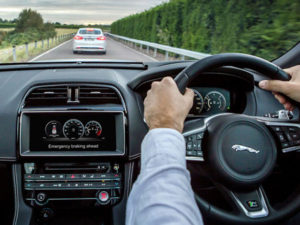New tech enables drivers to see around corners
UK Connected Intelligence Transport Environment (UK CITE) demonstrated its latest connected and autonomous car innovations at Jaguar Land Rover’s Gaydon site, which it says could lead to reduced congestion.

Self-overtaking vehicles, brake lights that communicate and cars that talk to traffic lights are amongst Jaguar’s ambitious plans for connected autonomous driving
Amongst the technologies demonstrated were Emergency Vehicle Warning (EVW), Emergency Electronic Brake Light (EEBL), Road Works Warning (RWW) and Traffic Condition Warning (TCW). These are designed to allow vehicle-to-vehicle communication, as well as V2X (vehicle-to-infrastructure) and offer advanced warnings to drivers, which is cited as a chief benefit of connected vehicles – whether manned or driverless.
Claire Lewis, senior business development manager at lead consortium partner, Visteon – responsible for the overall technical architecture of the project – said: “We have made significant strides with the development of our Phase 1 technologies.
“These technologies are set to have a wide societal and infrastructural impact. With advanced warnings of Emergency Vehicles on the road response times will improve, as traffic proactively responds to their presence. In the same vein, a more informed understanding of road conditions will allow traffic pressures to ease on the road.”
The £7.1m UK CITE project aims to create the UK’s first fully connected infrastructure to enable real-world testing in a safe and managed way and is funded by the Government’s £100m Connected and Autonomous Vehicle fund, delivered by Innovate UK.
Chris Holmes, connected and autonomous car and chassis research, senior manager, Jaguar Land Rover, said: “The technologies demonstrated by UK CITE will significantly help drivers and autonomous cars of the future understand unseen road hazards.”
Ian Thompson, senior technical adviser at Highways England, said: “Safety is our top priority and the safety of road users will continue to be an integral part of this project, especially during any on-road testing of this emerging technology.”
















